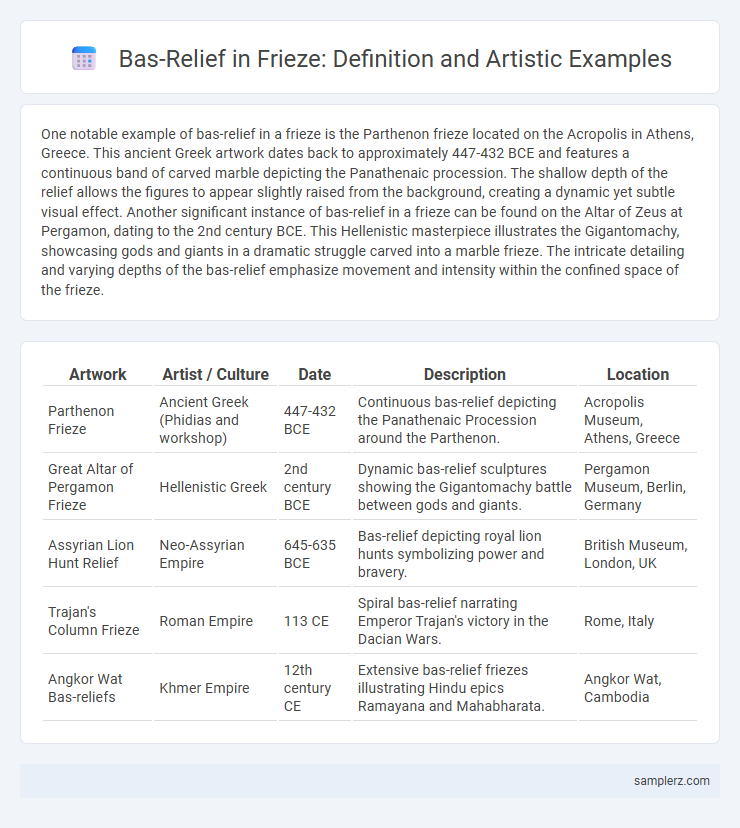One notable example of bas-relief in a frieze is the Parthenon frieze located on the Acropolis in Athens, Greece. This ancient Greek artwork dates back to approximately 447-432 BCE and features a continuous band of carved marble depicting the Panathenaic procession. The shallow depth of the relief allows the figures to appear slightly raised from the background, creating a dynamic yet subtle visual effect. Another significant instance of bas-relief in a frieze can be found on the Altar of Zeus at Pergamon, dating to the 2nd century BCE. This Hellenistic masterpiece illustrates the Gigantomachy, showcasing gods and giants in a dramatic struggle carved into a marble frieze. The intricate detailing and varying depths of the bas-relief emphasize movement and intensity within the confined space of the frieze.
Table of Comparison
| Artwork | Artist / Culture | Date | Description | Location |
|---|---|---|---|---|
| Parthenon Frieze | Ancient Greek (Phidias and workshop) | 447-432 BCE | Continuous bas-relief depicting the Panathenaic Procession around the Parthenon. | Acropolis Museum, Athens, Greece |
| Great Altar of Pergamon Frieze | Hellenistic Greek | 2nd century BCE | Dynamic bas-relief sculptures showing the Gigantomachy battle between gods and giants. | Pergamon Museum, Berlin, Germany |
| Assyrian Lion Hunt Relief | Neo-Assyrian Empire | 645-635 BCE | Bas-relief depicting royal lion hunts symbolizing power and bravery. | British Museum, London, UK |
| Trajan's Column Frieze | Roman Empire | 113 CE | Spiral bas-relief narrating Emperor Trajan's victory in the Dacian Wars. | Rome, Italy |
| Angkor Wat Bas-reliefs | Khmer Empire | 12th century CE | Extensive bas-relief friezes illustrating Hindu epics Ramayana and Mahabharata. | Angkor Wat, Cambodia |
Notable Bas-Relief Friezes in Ancient Architecture
The Parthenon in Athens hosts one of the most notable bas-relief friezes, depicting the Panathenaic procession with intricate human and animal figures in high detail. The Ara Pacis in Rome features bas-relief friezes symbolizing peace and prosperity, showcasing mythological and historical scenes with elegant depth. The Great Altar of Pergamon in modern-day Turkey displays a dramatic bas-relief frieze illustrating the Gigantomachy, emphasizing dynamic movement and expressive figures in Hellenistic art.
Bas-Relief Friezes in Classical Greek Temples
Bas-relief friezes in Classical Greek temples, such as those on the Parthenon's Doric frieze, depict detailed mythological and ceremonial scenes carved with shallow depth to create intricate visual narratives. These sculptural panels enhance the temple's architectural harmony while conveying significant cultural stories through stylized figures and dynamic compositions. The low-relief technique allows for subtle shadow play, emphasizing form and movement without overwhelming the structural elements.
Renaissance Masterpieces: Bas-Relief Friezes in Europe
Renaissance masterpieces such as Donatello's "Feast of Herod" exemplify intricate bas-relief friezes, showcasing sculpted depth and narrative detail on bronze panels. Lorenzo Ghiberti's "Gates of Paradise" on Florence's Baptistery feature exquisite bas-relief techniques, blending perspective and biblical storytelling. These works highlight the sophisticated use of bas-relief in enhancing architectural friezes across Europe during the Renaissance period.
Modern Interpretations of Bas-Relief Friezes
Modern interpretations of bas-relief friezes often incorporate mixed media and abstract forms, transforming traditional narrative panels into dynamic visual experiences. Artists like Frank Stella and Anish Kapoor use layered materials and innovative textures to create depth while maintaining the shallow relief characteristic of bas-reliefs. These contemporary friezes challenge classical motifs by emphasizing conceptual themes and interactive engagement within architectural spaces.
Iconic Bas-Relief Frieze Motifs and Symbolism
Iconic bas-relief frieze motifs often depict mythological scenes, historical events, or religious symbolism, serving as narrative devices in architecture. The Parthenon's frieze exemplifies this, illustrating the Panathenaic procession with detailed human and animal figures symbolizing civic pride and divine favor. Symbolism in these motifs conveys cultural values, such as victory, piety, and societal hierarchy, through stylized forms and recurring patterns.
Bas-Relief Techniques in Frieze Creation
Bas-relief techniques in frieze creation involve carving shallow, yet detailed, images that project slightly from the background, allowing intricate storytelling without significant depth. The Parthenon frieze exemplifies this method, showcasing delicate human figures with subtle variations in relief height to create dynamic visual effects. Skilled use of bas-relief enhances texture and light interplay, making narratives on stone surfaces vivid and engaging.
Impact of Bas-Relief Friezes on Public Spaces
Bas-relief friezes like the Parthenon frieze in Athens transform public spaces by integrating storytelling and architectural elegance, enriching cultural identity and historical awareness. These sculpted panels create dynamic visual narratives that engage viewers, fostering community interaction and enhancing the aesthetic appeal of urban environments. The tactile depth of bas-relief offers a timeless artistic method to commemorate events, celebrate heritage, and invite contemplation within shared public settings.
Preservation Challenges of Bas-Relief Friezes
Bas-relief friezes, such as those on the Parthenon in Athens, face significant preservation challenges due to environmental exposure and pollution, which cause erosion and surface degradation. Biological growth like moss and lichen further deteriorates the stone, while historical restoration attempts sometimes introduced incompatible materials leading to structural instability. Effective conservation requires controlled environments, regular maintenance, and advanced techniques like laser cleaning to ensure the longevity of these intricate artworks.
Famous Artists Known for Bas-Relief Friezes
Donatello is renowned for his bas-relief friezes, particularly in works like the "Feast of Herod," showcasing intricate depth and narrative detail. Lorenzo Ghiberti also gained fame for the bronze doors of the Florence Baptistery, which feature masterful bas-relief panels depicting biblical scenes. These artists exemplify the combination of sculptural technique and storytelling that defines bas-relief friezes in Renaissance art.
Cultural Significance of Bas-Relief Frieze Examples
Bas-relief friezes, such as those on the Parthenon in Athens and the Ara Pacis in Rome, embody cultural narratives and religious symbolism pivotal to ancient civilizations. These sculptural panels serve as visual storytelling mediums that document historical events, mythological tales, and societal values integral to Greek and Roman heritage. The enduring cultural significance of bas-relief friezes lies in their ability to connect contemporary audiences with the ideological and spiritual ethos of past societies through intricate artistic expression.

example of bas-relief in frieze Infographic
 samplerz.com
samplerz.com